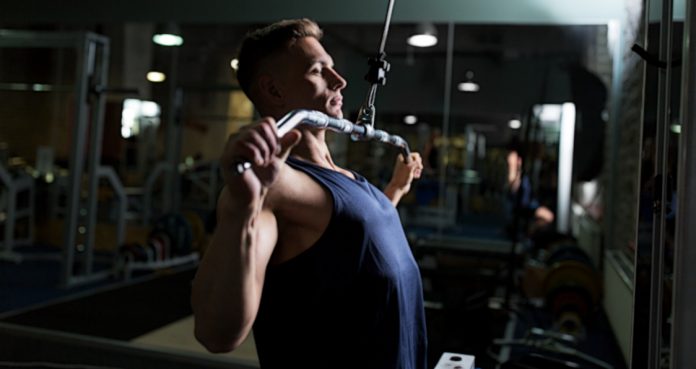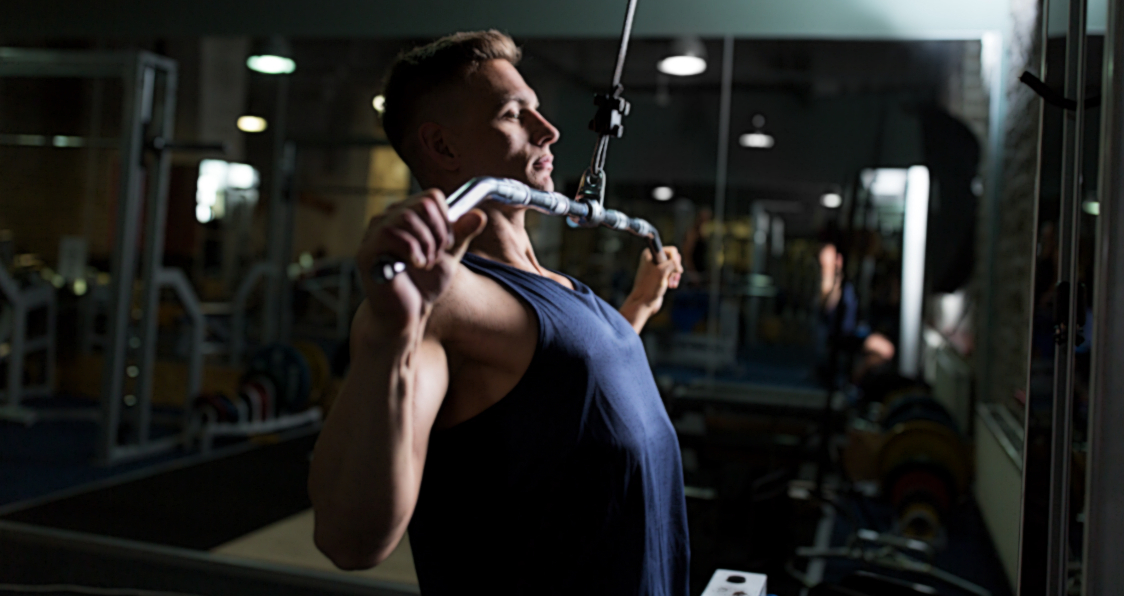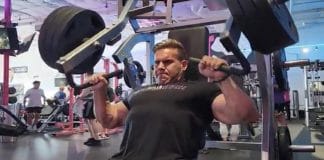
Cable Exercises For Strength Development
The cable machine is a superb, and often underutilized, piece of gym kit that can help to accelerate progress towards a multitude of health and fitness goals. One of the best things about the cable machine is its versatility. A wide range of effective strengthening exercises can be performed however, due to the many moving parts and handles, often the machine is used improperly or avoided altogether.
The cables are highly functional (1) and are specifically effective for increasing range of motion and for isolating specific muscle groups (2), which is of great benefit for those looking to build muscle strength, size or for rehabilitation from injury.
Setting Up The Cable Machine
The most important aspect to consider when setting up the cable machine is the amount of weight that is being lifted. For the beginner, start with light weight and prioritize technique over weight. The nervous system needs time to adapt and become accustomed to the movement patterns of the exercise (3). Only once proficient with technique should the weight gradually be increased.
Even for those who are more advanced lifters, technique should still take precedence. Picking a weight that is too heavy will more than likely cause technique to break down which will not only fail to work the specific muscles effectively, but will also increase the risk of experiencing injury.
The weight that is selected should align with one’s fitness goal. For increasing muscle mass, focus on 6-12 reps with every set as this has been found to be an effective range for onsetting hypertrophy (4). For strength gains, a heavier weight with lower reps is recommended, as again, this has been found to be most effective for building raw strength.
With some cable machines, the attachment is adjustable and can be moved higher and lower position. Prior to performing any exercise, make sure that the cable is set at the correct height for the chosen exercise.
Muscle Building Cable Exercises
As mentioned, there are a variety of exercises that can be performed to target a number of muscle groups. When assuming the correct position for each exercise ensure to brace the core to protect the back and reduce the chances of sustaining injury.
1) Cable Crossover
The cable crossover is a fantastic exercise for developing the pectorals and can facilitate improvements with the bench press.
With the cables set at a high point, grasp both handles and take a step backwards initially. From there, brace the core and pull the handles in to the chest. Walk forward with the handles tight to the chest, assume a staggered stance position and then “punch” the handles out, away from the body. Ideally, the arms should be slightly down from the height of the shoulders.
From that position, maintain straight arms and in a controlled fashion bring them out wide to the side of the body. Then focus on contracting the chest muscles in order to drive the arms together again and return to the starting position.
2) Decline Cable Flyes
Unlike with the decline bench press, the decline cable fly does not involve adjusting the body position, rather it refers to the angle of application. In simpler terms, instead of driving the arms together directly in front of the chest (as with the cable crossover), the arms start high and must drive the weight down towards the front leg.
This exercise is very similar to the cable crossover, both in terms of set-up and execution. As stated, the only variance is in regard to the angle of the movement. Ensure the cables are set at a high point, keep the arms straight and look to drive the weight downward.
3) Seated Cable Row
Possibly one of the best exercises for improving posture by strengthening the back and shoulders. For the seated row, take a seat and firmly plant the feet on the platforms. The legs should be relatively straight with only a slight bend maintained in both knees. Before grabbing the handle, drive the chest up, pull the shoulders back and squeeze the core muscles.
Start with arms extended and look to pull the handle in to the body (aiming for the area between the chest and stomach). As you pull, ensure to keep the elbows tucked in and focus on squeezing the muscles between the shoulder blades at the top of the movement. Under control, extend the arms while preventing any movement from the back and return to the starting position.
4) Bicep Cable Curl
When it comes to building muscle size, there is no doubt that the bicep curl is highly effective. For a bicep cable curl, ensure the cable is at the lowest point and attach a handle or a rope. Grasp the attachment and stand up tall, keeping the chest high and core tight to prevent the use of momentum. Pin the elbows in tight to the ribcage and focus on hinging only at the elbow to bring the hands up to the shoulders. Once at this point, squeeze the biceps and then reverse the movement under control.
5) Tricep Cable Extension
For comprehensive arm building, it is crucial to work the triceps as well as the biceps. To perform a tricep cable extension, start with the pulley at a high point and use a handle or rope. Keep the body upright, core engaged and chest up. Grab the attachment and, as with the bicep curl, fix the elbows to the sides of the ribcage. From there, flex at the elbows and drive the weight down to the hips and return, maintaining control.
6) Seated Cable Lat Pulldown
The lat pulldown is an exercise that is very regularly performed incorrectly. Many generate momentum from trunk movement to assist with every rep. Others pull the bar down behind the neck, rather than to the upper chest, which can cause problems in the long run.
Start by grasping the bar slightly wider than shoulder width and sit down with straight arms. Hook the legs under the pads to anchor the body in place, drive the chest up and brace hard. Pull the bar down, keeping it close to the face as it passes, until contact is made with the upper chest. Finally, return to the starting position by extending through until the arms are straight once again.
7) Standing Trunk Rotation
The last exercise is a core strength and stability exercise – more specifically, an oblique exercise. For the standing trunk rotation, ensure the cable is approximately at shoulder height and assume a hip-width stance. Grab the handle with both hands and keep the arms extended throughout. From there, powerfully rotate round and control the movement on the way back.
Be wary of leaning or bending during this exercise. Keeping the chest up and core tight should keep the body upright and force the obliques to work hard. Finally, ensure that the feet stay planted and that no movement occurs from the lower body.
Final Word
There is no doubt that the cable machine is certainly more complex than a number of other machines in the gym, but with regular practice, using the cables should become more straightforward, less daunting and will ultimately facilitate improvements in health and strength.
For more news and updates, follow Generation Iron on Facebook, Twitter, and Instagram.
References:
1-Balachandran, Anoop; Martins, Maria M.; De Faveri, Frederico G.; Alan, Ozgur; Cetinkaya, Funda; Signorile, Joseph F. (09 2016). “Functional strength training: Seated machine vs standing cable training to improve physical function in elderly”. Experimental Gerontology. 82: 131–138. doi:10.1016/j.exger.2016.06.012. ISSN 1873-6815. PMID 27354031.
2-Signorile, Joseph F.; Rendos, Nicole K.; Heredia Vargas, Hector H.; Alipio, Taislaine C.; Regis, Rebecca C.; Eltoukhy, Moataz M.; Nargund, Renu S.; Romero, Matthew A. (2017-2). “Differences in Muscle Activation and Kinematics Between Cable-Based and Selectorized Weight Training”. Journal of Strength and Conditioning Research. 31 (2): 313–322. doi:10.1519/JSC.0000000000001493. ISSN 1533-4287. PMID 28129277.
3-Services, Department of Health & Human. “Resistance training – health benefits”. www.betterhealth.vic.gov.au.
4-Schoenfeld, Brad J.; Peterson, Mark D.; Ogborn, Dan; Contreras, Bret; Sonmez, Gul T. (2015-10). “Effects of Low- vs. High-Load Resistance Training on Muscle Strength and Hypertrophy in Well-Trained Men”. Journal of Strength and Conditioning Research. 29 (10): 2954–2963. doi:10.1519/JSC.0000000000000958. ISSN 1533-4287. PMID 25853914.
















